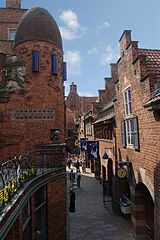House of St. Peter
The St. Petrus house , also called Petrushaus , in Bremer Böttcherstraße No. 3/5 was built between 1923 and 1927 based on designs by Eduard Scotland and Alfred Runge . It is one of the most interesting examples of German architecture from the interwar period and has been a listed building since 1973.
history
On Böttcherstraße (formerly Bötticherstraße ) there were several two-story, eaves-facing, small commercial buildings around 1900, which were demolished around 1921 as part of the new development on Böttcherstraße. Characteristic were several horizontal buttresses from wall to wall above the street.
Ludwig Roselius had convinced the Senate and the building authorities of the city with the plan to build a small colony for artists and small craftspeople with studios, shops and apartments near the market square, in line with the north German building tradition. In 1924, Roselius therefore acquired the heritable building right for 60 years from the Bremen state for the properties at Böttcherstrasse No. 15 to 19 (old number designations). After the renovation of the Roselius house and the packing houses at Böttcherstraße 4 to 5, the rebuilding of Böttcherstraße on the west side could be continued from 1924 to 1927.
The architects Runge and Scotland provided the designs for the development between the street Hinter dem Schütting and the square-like extension at the Roselius House. Initially, the entire complex was known as the HAG House , later the name St. Petrus House became established for the component south of the stepped gable .
The St. Petrus House, built from 1924 to 1927, was divided into several sub-areas as a shop with an arcade in front as an extension of the Hag House, then the clubhouse, in which the Bremen Society had its rooms from 1914 , and the gastronomy area with a restaurant. It once housed the Golden Hall as a lecture hall and behind the Gothic gable the lavishly designed St. Petrus wine restaurant .
In October 1944, incendiary bombs destroyed almost the entire Böttcherstrasse. The reconstruction was almost true to the original by 1954. The Permanent Representation restaurant in Flett is still located on the ground floor today . The Weinkontor St. Petrus is also located behind the Gothic gable in the building. From 1981 to 2010 the Casino Bremen was also located there . The Atlantic Grand Hotel has been operating the premises since August 2011 and has modernized the Golden Hall and the adjoining party rooms, the tent and the Scotland Hall . Behind the gable facade there has been the art & delicious gastro gallery since 2011 .
In 1979 Ludwig Roselius jun. the Kaffee HAG together with the Böttcherstrasse to General Foods and in 1981 the buyback of the Böttcherstrasse. In 1989, Sparkasse Bremen bought the entire street, including its buildings, except for the Atlantis building. In 2004 Böttcherstraße became part of the Bremer Sparer-Dank Foundation . It is operated by Böttcherstraße GmbH , a subsidiary of the financial holding company of the Sparkasse in Bremen.
Surname
Roselius wanted to set up a fish restaurant in this building. That is why the name Petrushaus or House St. Petrus was created for Peter , the patron saint of fishermen and fishmongers. Today's restaurant Fleet offers dishes in all areas.
Building
The two-storey, eaves brick building has a consistently low plot depth, with a moving ridge. In the design, the stylistic devices of a north German neo-Gothic were used as homeland security architecture with the inclusion of the regional building tradition. With dormer windows , galleries and gables , the architects succeeded in creating a varied facade design. Like all buildings on Böttcherstraße, the red bricks characterize the facades. The arcade for pedestrians on the ground floor took into account the traffic that was still possible at the time of construction.
Rudolf Alexander Schröder wrote that “the architects Runge and Scotland should be given high praise for the dignified and artistic restraint they laid around the preserved gemstone of the old Roselius shop,” he referred to the gable , "Which gives a very special happy point of view ..."
The Flett restaurant was designed around 1926 by Ernst Müller-Scheessel in the style of a Low German farmer's hall with a huge wagon wheel as a candlestick under the ceiling.
The small sculpture of the Bremen Town Musicians by Aloys Röhr was located on a round, narrow column on the curved staircase .
literature
- Hermann Gutmann: The Böttcherstrasse - A reading book . Döllverlag, Bremen 1993, ISBN 3-88808-077-0 .
- Felix Zimmermann: Böttcherstraße Bremen . Stadtwandel-Verlag, Berlin 2009, ISBN 978-3-86711-105-8 .
- Hans Tallasch (Ed.): Project Böttcherstraße . Aschenbeck & Holstein, Delmenhorst 2002, ISBN 3-932292-29-4 .
- Dehio manual : Bremen / Lower Saxony . Deutscher Kunstverlag , Munich / Berlin 1977.
See also
- Böttcherstrasse buildings :
- # 1: Robinson Crusoe House
- No. 2: House of Atlantis
- No. 3/5: House St. Petrus
- No. 4: House of Glockenspiel and Bremen-America Bank
- No. 6: Roselius House
- No. 7: House of the Seven Lazy or HAG House
- No. 8/9: Paula-Becker-Modersohn house
Individual evidence
- ^ Monument database of the LfD
- ^ Photos in E. Prosch: Old Bremen from old and new times , Fig. 26. Künstler-Verein / Hauschild, Bremen 1908.
- ^ Hermann Gutmann: Die Böttcherstrasse - A reading book. P. 102 f.
Web links
Coordinates: 53 ° 4 ′ 30.4 " N , 8 ° 48 ′ 20" E



